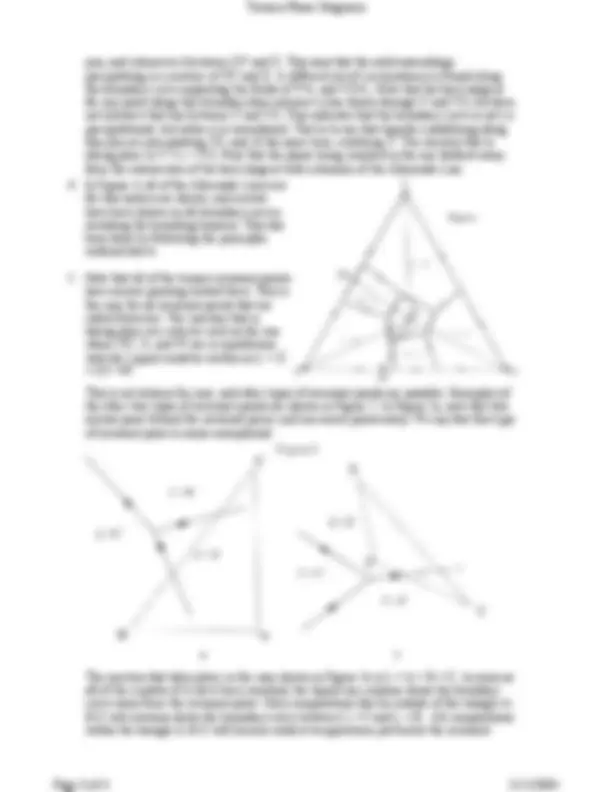




Study with the several resources on Docsity

Earn points by helping other students or get them with a premium plan


Prepare for your exams
Study with the several resources on Docsity

Earn points to download
Earn points by helping other students or get them with a premium plan
Community
Ask the community for help and clear up your study doubts
Discover the best universities in your country according to Docsity users
Free resources
Download our free guides on studying techniques, anxiety management strategies, and thesis advice from Docsity tutors
An in-depth explanation of ternary phase diagrams in the context of petrology. Students are expected to review binary and ternary phase diagrams covered in previous courses before class. The importance of identifying phases that can coexist during crystallization or melting, and the significance of alkemade lines in determining the crystallization path. It also explains the difference between coprecipitational and resorptional boundary curves.
Typology: Schemes and Mind Maps
1 / 4

This page cannot be seen from the preview
Don't miss anything!



This document last updated on 12-Feb-
EENS 212 Petrology Prof. Stephen A. Nelson Tulane University
In our discussion of ternary phase diagrams, we will first review and then expanding on material covered last semester in Earth Materials on binary and ternary phase diagrams. You should therefore spend some time reviewing this material. Links are as follows -
http://www.tulane.edu/~sanelson/eens211/2compphasdiag.html or for the PDF version - http://www.tulane.edu/~sanelson/eens211/2compphasdiag.pdf and http://www.tulane.edu/~sanelson/eens211/ternaryphdiag.htm or for the PDF version - http://www.tulane.edu/~sanelson/eens211/ternaryphdiag.pdf
Bring both sets of lecture notes with you to class. After reviewing this material we will proceed with the following discussion:
When presented with a complex phase diagram, the first thing one must do is understand what phases can coexist during crystallization or melting, and what phases coexist in all possible subsolidus assemblages. Remember that in a ternary system at constant pressure, the maximum number of phases that can coexist is 4, and 4 phases can only exist at ternary invariant points (F= C+1-P, if F=0, C=3, then P = 4). Knowing what phases must be present in the subsolidus assemblage for any composition in the system is important, because it tells us where the crystallization path will lead, i.e. to which of the invariant points in the system where 3 solid phases and a liquid will coexist prior to the disappearance of the liquid phase. Univariant curves, also called cotectics, are lines along which 3 phases coexist at constant pressure (F =1, C=3, so P = 3). Such curves bound the primary phase fields (divariant fields), and by inspection of the phases that exist on either side of the curves, one can tell which phases are crystallizing as the liquid composition moves along the curve. Furthermore, in the absence of isotherms or other temperature information, one can determine the down-temperature direction that a liquid will move along such a curve. The method is as follows:
An Alkemade line can thus be drawn between X and XY.
Similarly, the boundary curve between XY+L and W+L indicates that XY and W coexist along that curve, and so an Alkemade Line is drawn between the composition of XY and the composition of W. Also, along the boundary curve separating the fields of W+L from X+L, solid phases X and W are in equilibrium, so an Alkemade Line is drawn between the composition of phase W and the composition of phase X. These three Alkemade Lines are shown in Figure 2, as dotted lines. Note that these lines form a 3 phase triangle and any composition within this triangle must end up with XY, X, and W as the final solid assemblage.
Note that the Alkemade Line for equilibrium between XY and W, crosses the boundary curve where XY, W and Liquid coexist. Thus, the down-temperature direction points toward the bottom of the diagram for all liquids below the XY-W join, and towards the top of the diagram for all liquids on the boundary curve above the XY-W join. This is shown in Figure 3, where the down temperature arrows have been drawn. Note that when the Alkemade Lines for a given assemblage crosses the boundary curve representing equilibrium for the same assemblage + Liquid, that the intersection of the boundary curve and the Alkemade Line is a thermal divide.
Retrun to EENS 212 Page
point.
Another case is shown in Figure 5b. Here, two arrows point away from the invariant point and one arrow points toward it. This point is a bi-resorptional invariant point. In the case shown, three different reactions are possible, depending on the bulk composition of the material in question. These are:
For reaction (1) X is completely resorbed and Y is partially resorbed at the invariant point. This would occur for all composition which lie in a compositional triangle that does not include X.
For reaction (2) Y is completely resorbed and X is partially resorbed. This would occur for all compositions which lie in a compositional triangle that does not include Y.
Reaction 3 would occur for all compositions within the compositional triangle, X, Y, and Z. Phases X and Y would both be partially resorbed at the invariant point, and crystallization would cease at Temperatures just below the invariant point, with only solid phases X, Y and Z in equilibrium.